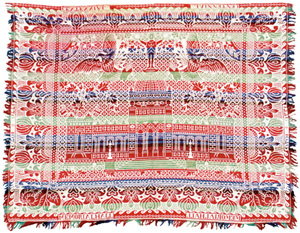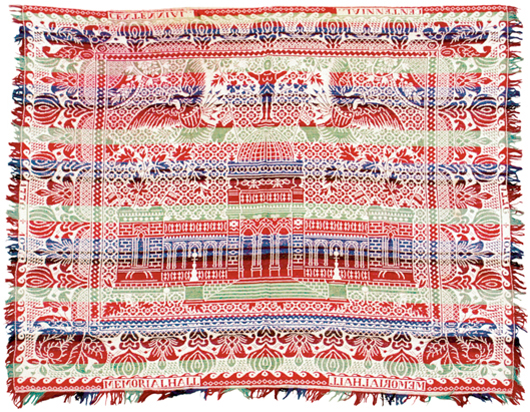
In the winters of earlier centuries, rooms could become very cold. Heat came only from a fireplace, and a glass of water just 6 feet from the flames could freeze. So blankets, coverlets and quilts were necessities. Only the very rich could import fabrics, most had to use homemade or at least locally made bed covers.
In the 18th and early 19th centuries, the housewife furnished the wool for a coverlet. White wool sheared from the family sheep was dyed with indigo for blue, red from madder root and yellow from goldenrod or sumac. Black wool came from black sheep. Then the wool was spun on a wheel and woven on a loom. Strips 3 yards long and 42 inches wide were stitched together to make a coverlet. In about 1800, traveling weavers started working in New England, New York, Pennsylvania and Ohio. Women were delighted to be able to buy the finished coverlets. In 1801 the Jacquard loom was invented, and by 1820 it was in use in the United States. It used a series of punch cards to move the threads and create complicated three-color patterns. Large looms could make a full-size coverlet in one piece.
Most of the weaving was done in factories by the 1870s.
Many woven coverlets were marked in a corner with the name of the weaver and sometimes the name of the owner, the county or city and the date. Very elaborate jacquard coverlets were made and sold at major events like world’s fairs. These often pictured buildings and patriotic sayings. Several different 1876 Philadelphia Centennial Exposition coverlets auction for $600 to $800. Some designs have seven colors. If the fringe is in good condition, the colors bright and the coverlet free of moth holes, the price is higher. They can be hung on a wall or used as a bedspread.
Q: My parents left me a walnut Windsor chair that was the first piece of furniture they bought after they were married in 1920. The paper label on the bottom of the seat reads “Phoenix Chair Co., Sheboygan, Wisconsin, U.S.A.” Somewhere I read that 18th-century Windsor chairs were always painted very dark green. I would like to know if it’s OK for me to paint it dark green.
A: Phoenix Chair Co. was in business from about 1875 into the 1950s. If your parents’ chair was made around 1920 and is in decent shape, it would sell for about $50. Walnut is a nice unpainted wood, but if you prefer dark green go ahead and paint the chair. However, it is not true that all 18th-century Windsor chairs were painted dark green. Many were painted black or even left unpainted.
Q: Before my parents were married (I’m 87), my father gave my mother a bisque Kewpie figurine that’s 8 inches tall. Kewpie is sitting in a blue chair with a high back and is holding a single rose. The only mark I can find on it is “1912” on the bottom.
A: Kewpies, little naked angelic babies with small wings, were the creation of American illustrator Rose O’Neill. They first appeared in 1909 as drawings in Ladies’ Home Journal, but within a few years dolls and figurines were being produced. The earliest figurines were bisque, like yours, and were made in Germany. Production rights were controlled by Geo. Borgfelt & Co., a New York City importer. Kewpies as old as yours sell for high prices if they’re in excellent condition. One that matches the description of yours sold for more than $900 at a recent doll auction.
Q: My old tabletop slot machine is called a “Twin Jack Pot.” It’s 19 1/2 inches high, 15 inches wide and 14 inches deep. The front and top are cast iron, the sides and platform wood and the back heavy-gauge steel. It must weigh close to 75 pounds. All the parts appear to be original and everything works. There’s a “W” cast into the top face of the machine. Please tell me more about the machine and its value.
A: Your Twin Jack Pot slot machine is a classic model introduced in 1931 by the Watling Manufacturing Co. of Chicago. Slots and other coin-operated gaming machines were very popular in the United States from the 1890s until 1951, when a federal law went into effect that prohibited the interstate shipment of gambling devices except to states where the devices were legal. Watling, which had been founded in 1901, stayed in business another 15 years, but it primarily made scales. Twin Jack Pots sell today for more than $1,500.
Q: I found an old glass bottle about the size of a regular Coke bottle but with straight sides. The bottom of the bottle is embossed “Coca-Cola Bottling Co., Terre Haute, Ind.” The side of the bottle is embossed “Coffey and Souders, Terre Haute, Ind.” How old is the bottle and is it worth anything?
A: Your Coke bottle is about 100 years old. Edgar Coffey and Elmer Souders of Terre Haute purchased franchise rights to bottle Coke in 1904 and incorporated the Coca-Cola Bottling Co. of Terre Haute in 1908. The company, still in business, bottled Coke for local consumers until the late 1980s. Straight-sided glass bottles were used by Coke bottlers from about 1903 to 1916-17, when the now-standard Coca-Cola bottle was introduced. That bottle design was the brainchild of another Terre Haute man, Chapman J. Root. Your bottle would probably sell for about $30.
Tip: Missing an earring? An antique drop earring can be converted to a necklace pendant. Very fashionable today.
Terry Kovel answers as many questions as possible through the column. By sending a letter with a question, you give full permission for use in the column or any other Kovel forum. Names, addresses or email addresses will not be published. We cannot guarantee the return of any photograph, but if a stamped envelope is included, we will try. The volume of mail makes personal answers or appraisals impossible. Write to Kovels, Auction Central News, King Features Syndicate, 300 W. 57th St., New York, NY 10019.
CURRENT PRICES
Current prices are recorded from antiques shows, flea markets, sales and auctions throughout the United States. Prices vary in different locations because of local economic conditions.
- Souvenir plate, GAR, white ironstone, purple rim band, transfer pattern, members medal, Post 71, 1884, 8 inches, $12.
- Celluloid button, Saint Anne and Virgin Mary, Diedrich Schaefer Co., 3 inches, $12.
- Girl Scout uniform, junior, hat, belt, purse, sash, tie, green and yellow, 1960, size 10, $69.
- “Dun Workin” sign, wood panel, applied molding, black and white paint, c. 1900, 9 1/4 x 27 inches, $770.
- Barber’s mug rack, carved oak, 40 compartments, 44 1/2 x 41 1/2 inches, $880.
- Bronze candlestick, Gothic, ormolu, reeded shaft, 8-sided base, border, France, c. 1850, 11 1/2 inches, pair, $956.
- Oil lamp, metal, porcelain, frosted globe, putti, lilac and green, E. Drouet, Sevres, France, 1897, 19 x 32 inches, $2,000.
- Newcomb pottery vase, narcissus, high relief, blue, green, yellow, Anna Frances Simpson, 1929, 6 3/4 inches, $2,151.
- Clock, Gothic style, cathedral, gilt bronze, rose window dial, fluted columns, c. 1890, 16 x 7 inches, $2,390.
- Gothic Revival chair, mahogany, carved, lancet back, silk slip seat, c. 1840, 35 1/2 inches, $2,988.
Available now. The best book to own if you want to buy, sell or collect – and if you order now, you’ll receive a copy with the author’s autograph. The new Kovels’ Antiques & Collectibles Price Guide, 2013, 45th edition, is your most accurate source for current prices. This large-size paperback has more than 2,500 color photographs and 40,000 up-to-date prices for more than 775 categories of antiques and collectibles. You’ll also find hundreds of factory histories and marks, a report on the record prices of the year, plus helpful sidebars and tips about buying, selling, collecting and preserving your treasures. Available online at Kovelsonlinestore.com; by phone at 800-303-1996; at your bookstore; or send $27.95 plus $4.95 postage to Price Book, Box 22900, Beachwood, OH 44122.
© 2012 by Cowles Syndicate Inc.

ADDITIONAL IMAGE OF NOTE


